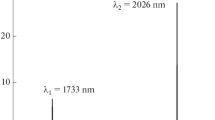Abstract
The results of experimental studies of the effect of pumping conditions on the spectral and temporal characteristics of IR Ar I laser radiation under excitation of the active medium by longitudinal pulsed inductive discharge are presented. The lasing was obtained at transitions of neutral argon atoms at wavelengths of 1213, 1240, 1270, 1694, and 1791 nm in pure argon and in its two-component mixtures with helium and neon. The optical pulse length at half maximum was (5 ± 1) ns. The radiation energy attained 0.1 mJ.




Similar content being viewed by others
REFERENCES
P. O. Clark, “Investigation of the operating characteristics of the 3.5 μ xenon laser,” IEEE J. Quantum Electron. 1 (3), 109–113 (1965).
S. L. Jacques and D. J. McAuliffe, “The melanosome: Threshold temperature for explosive vaporization and internal absorption coefficient during pulsed laser irradiation,” Photochem. Photobiol. 53 (6), 769–775 (1991).
B. I. Vasil’ev and U. M. Mannun, “IR differential-absorption lidars for ecological monitoring of the environment,” Quantum Electron. 36 (9), 801–820 (2006).
A. A. Andronov, N. G. Zakharov, A. V. Marugin, and A. P. Savikin, New IR and THz Sources and Detectors (NNSU, Nizhny Novgorod, 2007) [in Russian].
O. A. Romanovskii, “Airborne DIAL lidar gas analysis of the atmosphere by middle IR gas lasers: Numerical modeling,” Opt. Mem. Neural Networks 17 (2), 131–137 (2008).
A. I. Konak, S. P. Mel’nikov, V. V. Porkhaev, and A. A. Sinyanskii, “Lasing on the IR transitions in krypton and argon atoms due to excitation of active media with uranium fission fragments,” Quantum Electron. 22 (6), 511–515 (1995).
A. V. Karelin, V. F. Tarasenko, and S. I. Yakovlenko, “High-pressure atom and atomic-ion laser,” Laser Phys. 10 (4), 827–844 (2000).
J. W. Shon and M. J. Kushner, “Excitation mechanisms and gain modeling of the high-pressure atomic Ar LASER in He/Ar mixtures,” J. Appl. Phys. 75 (4), 1883–1890 (1994).
A. Yu. Dudin, D. A. Zayarnyi, L. V. Semenova, N. N. Ustinovskii, I. V. Kholin, and A. Yu. Chugunov, “Electron-beam-pumped laser utilizing mixtures of Xe, Kr, and Ar with two-component buffer gases,” Quantum Electron. 21 (11), 1172–1175 (1991).
P. L. Chapovsky, V. N. Lisitsyn, and A. R. Sorokin, “High-pressure gas lasers on Ar I, Xe I, and Kr I transitions,” Opt. Commun. 16 (1), 33–36 (1976).
O. R. Wood, E. G. Burkhardt, M. A. Pollack, and T. J. Bridges, “High-pressure laser action in 13 gases with transverse excitation,” Appl. Phys. Lett. 18 (4), 112–115 (1971).
G. J. Linford, “High-gain neutral laser lines in pulsed noble-gas discharge,” IEEE J. Quantum Electron. 8 (6), 477–482 (1972).
A. M. Razhev, D. S. Churkin, and E. S. Kargopol’tsev, “IR lasing on atomic xenon with pumping by longitudinal pulse inductive discharge,” Laser Phys. Lett. 12 (4) (2019).
V. V. Kazakov, V. G. Kazakov, V. S. Kovalev, O. I. Meshkov, and A. S. Yatsenko, “Electronic structure of atoms: Atomic spectroscopy information system,” Phys. Scr. 92 (10), 1–6 (2017).
V. N. Lisitsyn and A. R. Sorokin, “Pulsed lasing mechanism in a high-pressure electrical-discharge Ar-Xe laser,” Quantum Electron. 8 (11), 1481–1484 (1981).
A. R. Sorokin, “Mechanism of pulse emission from high-pressure electric-discharge He–Ar, He–Kr, and He–Xe infrared lasers,” Quantum Electron. 13 (2), 165–171 (1983).
Funding
The research results presented in the work were obtained within the state assignment (theme no. AAAA-A17-117030310293-6).
Author information
Authors and Affiliations
Corresponding authors
Ethics declarations
The authors declare that they have no conflict of interest.
Rights and permissions
About this article
Cite this article
Razhev, A.M., Churkin, D.S. & Tkachenko, R.A. Pulsed Inductive IR Ar I laser. Atmos Ocean Opt 33, 435–438 (2020). https://doi.org/10.1134/S1024856020040119
Received:
Revised:
Accepted:
Published:
Issue Date:
DOI: https://doi.org/10.1134/S1024856020040119




